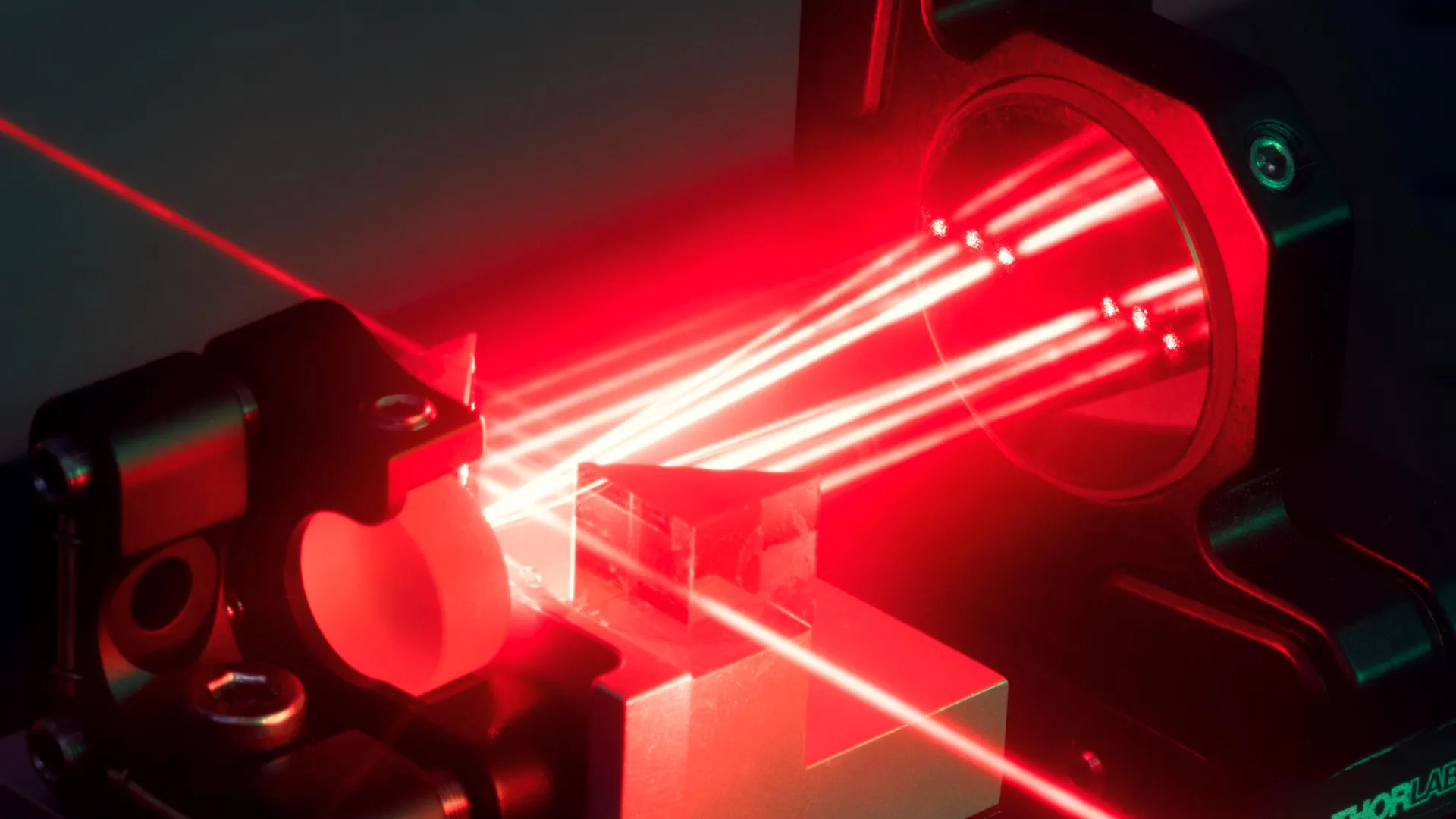Tiny laser could transform medicine and quantum science
Tiny laser, massive leap—80% efficiency in the palm of your hand.
- Date:
- November 9, 2025
- Source:
- Universitaet Stuttgart
- Summary:
- A team at the University of Stuttgart has engineered a compact short-pulse laser that achieves up to 80% efficiency—far surpassing current models. Their new multipass design reuses light within a small crystal, combining power and precision in a palm-sized system. It opens the door to portable, cost-effective lasers for medicine, analytics, and quantum science.
- Share:

Lasers that produce ultrashort light pulses deliver exceptional precision for manufacturing, medicine, and scientific studies. The catch is that high-efficiency short-pulse systems usually take up significant space and come with high costs. A team at the University of Stuttgart, working with Stuttgart Instruments GmbH, has introduced a compact alternative. Their device is more than twice as efficient as many existing setups, small enough to rest in a hand, and designed for broad use. The approach is reported in Nature.
"With our new system, we can achieve levels of efficiency that were previously almost unattainable," says Prof. Harald Giessen, Head of the 4th Physics Institute at the University of Stuttgart. In tests, the team showed that short-pulse lasers can fundamentally reach 80% efficiency. In practical terms, 80% of the input power becomes usable output. "For comparison: current technologies achieve only about 35% -- which means they lose much of their efficiency and are correspondingly expensive," explains Giessen.
A lot of energy in an extremely short time
Short-pulse lasers emit bursts that last for only nano-, pico-, or femtoseconds (i.e., a few billionths to quadrillionths of a second). Because the pulses are so brief, a large amount of energy can be delivered to a tiny spot almost instantly. The setup combines a pump laser with the short-pulse laser. The pump laser delivers light energy to a special crystal. This crystal drives the process by transferring energy from the pump beam to the ultrashort signal pulse. In doing so, the incoming light particles are converted to infrared light. Infrared enables experiments, measurements, or production steps that visible light cannot achieve. In industry, short-pulse lasers are used in production -- for example, for precise and gentle material processing. They are also employed in medical imaging and in quantum research for exceptionally exact measurements at the molecular scale.
"Designing short-pulse lasers efficiently remains an unsolved challenge," explains Dr. Tobias Steinle, lead author of the study. "In order to generate short pulses, we need to amplify the incoming light beam and cover a wide range of wavelengths." Until now, it has not been possible to combine both properties simultaneously in a small and compact optical system." Wide-bandwidth laser amplifiers typically need crystals that are very short and thin. High-efficiency amplifiers, in contrast, favor much longer crystals. One workaround is to connect several short crystals in series, an approach already explored in research. Whatever the choice, the timing between the pump and signal pulses must stay synchronized.
New multipass concept
The team addresses this trade-off with a multipass strategy. Rather than relying on one long crystal or stacking many short ones, they run the light repeatedly through a single short crystal inside an optical parametric amplifier. After each pass, the separated pulses are carefully realigned to maintain synchronization. The result is a system that produces pulses shorter than 50 femtoseconds, takes up only a few square centimeters, and uses just five components.
"Our multipass system demonstrates that extremely high efficiencies need not to come at the expense of bandwidth," explains Steinle. "It can replace large and expensive laser systems with high power losses, which were previously required to amplify ultrashort pulses." The design can also be tuned for wavelengths beyond the infrared and adapted to different crystals and pulse durations. Building on this concept, the researchers aim to create small, lightweight, compact, portable, and tunable lasers that can set wavelengths with precision. Likely use cases include medicine, analytical techniques, gas sensing, and environmental monitoring.
Financial support came from the Federal Ministry of Research, Technology and Space (BMFTR) through the KMU-Innovativ program, the Federal Ministry for Economic Affairs and Energy (BMWE), the Baden-Wuerttemberg Ministry of Science, Research and the Arts, the German Research Foundation (DFG), the Carl Zeiss Foundation, the Baden-Wuerttemberg Foundation, the Center for Integrated Quantum Science and Technology (IQST), and the Innovation Campus Mobility of the Future (ICM). The work was carried out by the 4th Physics Institute of the University of Stuttgart in collaboration with Stuttgart Instruments GmbH under the MIRESWEEP project (a novel, cost-effective tunable mid-infrared laser source for analytical applications).
Story Source:
Materials provided by Universitaet Stuttgart. Note: Content may be edited for style and length.
Journal Reference:
- Jan H. Nägele, Tobias Steinle, Johann Thannheimer, Philipp Flad, Harald Giessen. Dispersion-engineered multipass optical parametric amplification. Nature, 2025; 647 (8088): 74 DOI: 10.1038/s41586-025-09665-w
Cite This Page: